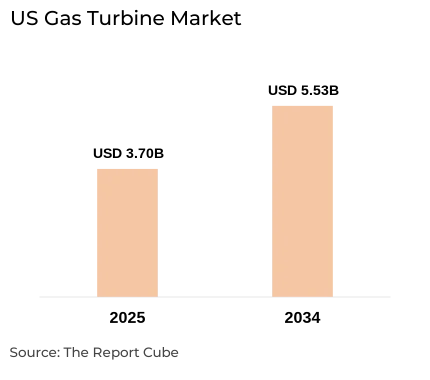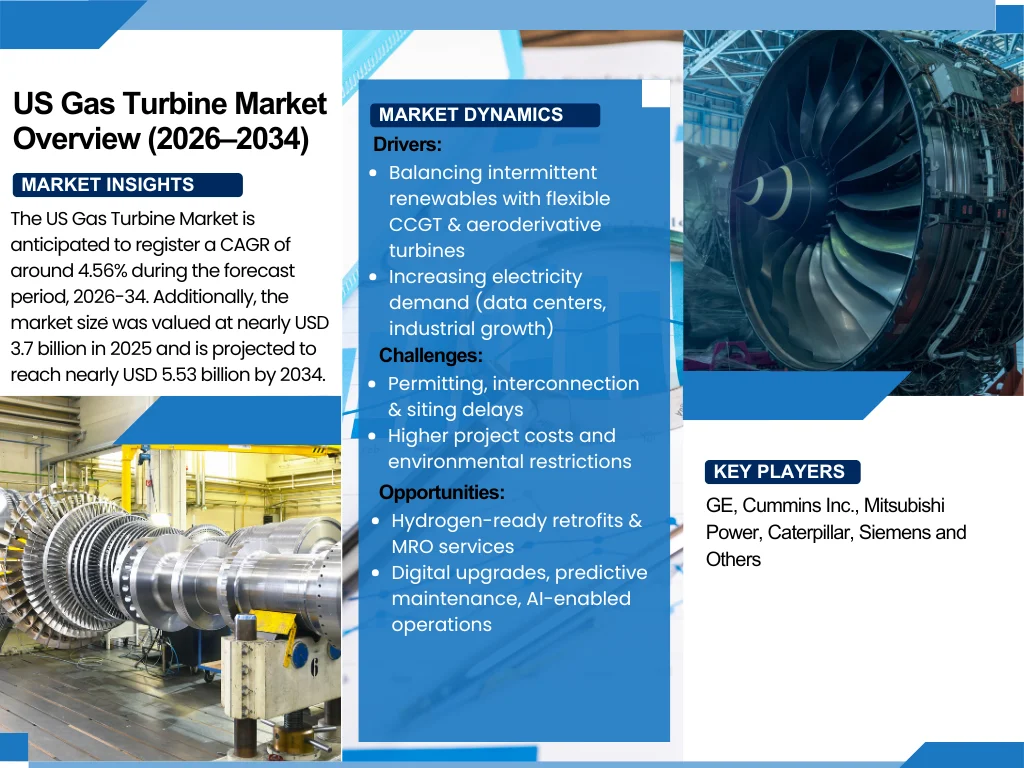
Understand The Key Trends Shaping This Market
Download Free SampleUS Gas Turbine Market Overview: Market Analysis & Insights
What is the anticipated CAGR & size of the US Gas Turbine Market?
The US Gas Turbine Market is anticipated to register a CAGR of around 4.56% during the forecast period, 2026-34. Additionally, the market size was valued at nearly USD 3.7 billion in 2025 and is projected to reach nearly USD 5.53 billion by 2034.
Market Insights & Analysis
The US Gas Turbine Market is destined for sturdy growth during 2026–34 as utilities & Independent Power Producers (IPPs) chase flexible, high-efficiency capacity to balance increasing electricity demand & intermittent renewables. Also, combined-cycle capacity expansion, fleet repowering, and peaker replacement are instigating orders for combined cycle gas turbine (CCGT) & heavy-duty gas turbine units.
Moreover, government initiatives, including the US Department of Energy’s (DOE) Hydrogen Shot Initiative & the Inflation Reduction Act (IRA) 2022 are embracing the adoption of hydrogen-ready gas turbines & incentivizing utilities to transition toward low-carbon power generation. Hence, these programs boost turbine retrofits, hydrogen co-firing, and carbon capture incorporation across existing fleets, ensuring that gas turbines remain fundamental across the energy transition.
Furthermore, manufacturers, such as GE Vernova, Siemens Energy, Mitsubishi Power, and Solar Turbines strive on hydrogen-blend capability, fast-start peaking, and digital services. Along with this, recent 2024–25 advancements include GE Vernova securing aeroderivative turbine orders for a novel Missouri peaking plant & Mitsubishi Power delivering simple-cycle units to Georgia Power, showcasing active fleet innovation in the US Gas Turbine Market.
In addition, long-term service agreements (LTSA) & aftermarket MRO continue to be fundamental sources of income as operators implement intelligent upgrades & prolong asset life. Further, looking ahead, the US Gas Turbine Industry's next progression phase would be defined by decarbonization guidelines, hydrogen readiness, digitalization, and AI-driven predictive maintenance. Therefore, these aspects would encourage OEM competitiveness & equipment innovation through 2034, further enhancing US Gas Turbine Market share.
What is the Impact of AI in the US Gas Turbine Market?
AI & advanced analytics optimize dispatch, predictive maintenance, fuel-mix management, and remote diagnostics in the US Gas Turbine Market. This, in turn, is improving availability, cutting lifecycle prices, and enabling hydrogen-blend operations, while digital twins & condition monitoring hastens fleet turnarounds & O&M efficacy.
US Gas Turbine Market Dynamics
What driving factor acts as a positive influencer for the US Gas Turbine Market?
- Flexible Capacity to Balance Renewables to Instigate Market Growth: Increasing renewable penetration & booming electricity demand (notably from data centers) need fast, effective, flexible gas turbine capacity, preferring CCGT & aeroderivative peakers that could cycle with variable generation. Also, EIA outlooks represent increasing power demand in 2026, sustaining gas turbine requirements.

What are the challenges that affect the US Gas Turbine Market?
- Permitting, Interconnection & Siting Restraints to Limit Market Growth: In addition to cost issues, the US Gas Turbine Market also has to oppose with community opposition, protracted permitting procedures, and overdue connections. Also, these elements impact total project schedules & investor confidence by decelerating project approvals, raising risks, and making it more challenging to construct new combined-cycle (CCGT) plants, specifically in areas with stricter environmental regulations & inhibited grid capacity.
How are the future opportunities transforming the market during 2026-34?
- Hydrogen-Ready Retrofits & Aftermarket Expansion: Producers & plant owners are upgrading turbines for hydrogen-blend operations, utilizing digital retrofits & maintenance, repair, and overhaul (MRO) contracts to outspread equipment life. Also, these advancements assist lower emissions, improves efficiency, and generate sturdy aftermarket revenue as global OEMs expand production capacity to meet increasing demand for hydrogen-ready solutions.
What market trends are affecting the US Gas Turbine Market Outlook?
- Digital Services & Long-Term Service Agreements (LTSA): The market is transitioning from one-time equipment sales to service-based models, where digital monitoring, predictive analytics, and long-term maintenance agreements ensure uninterrupted performance. Moreover, these assimilated solutions improve reliability, decrease downtime, and offer recurring revenue for manufacturers while facilitating operators manage assets proficiently across their gas turbine fleets.
How is the US Gas Turbine Market Defined as per Segments?
The US Gas Turbine Market Research Reports provide detailed market data & insights in accordance with market segmentation. Some of the segments are:
- Technology: Open Cycle Gas Turbine (OCGT) & Combined Cycle Gas Turbine (CCGT)
- Fuel Type: Natural Gas, Hydrogen or Hydrogen-Blend Fuels, and Other Liquid Fuels
By Technology:
The Combined Cycle Gas Turbine (CCGT) segment dominates the US Gas Turbine Market, capturing the largest market share. This is due to superior thermal efficacy & lower CO₂ intensity, making it the favored choice for baseload & flexible mid-merit capacity. Furthermore, utilities repowering older steam plants with CCGT & adding combined-cycle blocks deliver greater output per fuel input, decreasing operational costs & emissions through 2034.
By Fuel Type:
The Natural Gas segment remains the leading fuel type across the US Gas Turbine Market, accounting for the prominent market share. This is owing of feedstock obtainability, established infrastructure, and competitive pricing. Nevertheless, hydrogen-blend capability is increasing as OEMs certify units for partial H₂ & utilities pilot blends. Also, natural gas would drive near-term demand, while hydrogen-ready designs shape medium-term decarbonization trails.
US Gas Turbine Market: What Recent Innovations Are Affecting the Industry?
- 2025: GE Vernova secured aeroderivative gas turbine order for the McCartney Generating Station in Missouri (new peaking capacity), representing hydrogen‐capable aeroderivative deployment & fast-ramping solutions.
- 2025: Mitsubishi Power delivered the first of new simple-cycle combustion turbines to Georgia Power’s Plant Yates, replicating active fleet modernization & OEM production in the US market.
What are the Key Highlights of the US Gas Turbine Market (2026–34)?
- The US Gas Turbine Market was predicted at about USD 3.7 billion in 2025 and is anticipated to expand at nearly CAGR of 4.56% during 2026-34.
- Combined-cycle (CCGT) & heavy-duty gas turbines lead capacity additions, as well as aeroderivative units to expand in peaking roles.
- OEMs to compete on hydrogen-blend capability, digital services, retrofits, and long‐term service models.
- Aftermarket MRO & LTSA (long-term service agreements) create steady recurring revenues.
- AI & analytics to enable predictive maintenance, dispatch optimization, and lifecycle cost deduction.
How does the Future Outlook of the US Gas Turbine Market (2034) Appears?
Through 2034, the US Gas Turbine Market would be characterized by prevalent CCGT efficiency gains, hydrogen-blend operational capability, and mature digital service ecosystems. Moreover, continued demand from grid balancing, data centers, and industrial users, together with AI-enabled operations & LTSA models, would sustain OEM competitiveness & a vibrant aftermarket, even as decarbonization pressures augments hydrogen adoption in the forecast years.
What Does Our US Gas Turbine Market Research Study Entail?
- The US Gas Turbine Market Research Report highlights the forecast growth rate (CAGR) by anticipating the market size and share.
- The market analysis & market scope sheds light upon the primary industry trends, driving aspects, potential opportunities, growth challenges, and other major factors.
- The US Gas Turbine Market Research Report entails details about the most critical shifts in market share in the prominent regions.
- Considering the statistics & the developments by the primary market competitors, our report also strives to demonstrate the most sought-after strategies of the key players.
Table of Contents
- Introduction
- Objective of the Study
- Product Definition
- Market Segmentation
- Study Variables
- Research Methodology
- Secondary Data Points
- Companies Interviewed
- Primary Data Points
- Breakdown of Primary Interviews
- Secondary Data Points
- Executive Summary
- Market Dynamics
- Drivers
- Challenges
- Opportunity Assessment
- Recent Trends and Developments
- Policy and Regulatory Landscape
- US Gas Turbine Market Overview
- Market Size, By Value (USD Billion)
- Market Share, By Technology
- Open Cycle Gas Turbine (OCGT)
- Combined Cycle Gas Turbine (CCGT)
- Market Share, By Fuel Type
- Natural Gas
- Hydrogen or Hydrogen-Blend Fuels
- Other Liquid Fuels
- Market Share, By Turbine Type
- Heavy Duty
- Industrial
- Aeroderivatives
- Market Share, By End User
- Power Generation
- Oil & Gas
- Other Industrial
- Market Share, By Competitors
- Revenue Shares
- Competition Characteristics
- Segment-wise Market Overviews (2026–2034)
- By Value (USD Billion)
- By Technology (2026–2034)
- By Fuel Type (2026–2034)
- By Turbine Type (2026–2034)
- By End User (2026–2034)
- Competitive Outlook (Company Profiles)
- GE
- Company Overview
- Business Segments
- Strategic Alliances/Partnerships
- Recent Developments
- Cummins Inc.
- Company Overview
- Business Segments
- Strategic Alliances/Partnerships
- Recent Developments
- Mitsubishi Power
- Company Overview
- Business Segments
- Strategic Alliances/Partnerships
- Recent Developments
- Caterpillar
- Company Overview
- Business Segments
- Strategic Alliances/Partnerships
- Recent Developments
- Siemens
- Company Overview
- Business Segments
- Strategic Alliances/Partnerships
- Recent Developments
- Solar Turbines
- Company Overview
- Business Segments
- Strategic Alliances/Partnerships
- Recent Developments
- Wärtsilä
- Company Overview
- Business Segments
- Strategic Alliances/Partnerships
- Recent Developments
- Capstone Green Energy Corporation
- Company Overview
- Business Segments
- Strategic Alliances/Partnerships
- Recent Developments
- Vericor Power Systems LLC
- Company Overview
- Business Segments
- Strategic Alliances/Partnerships
- Recent Developments
- Kawasaki Heavy Electrical Limited
- Company Overview
- Business Segments
- Strategic Alliances/Partnerships
- Recent Developments
- GE
- Contact Us & Disclaimer
List of Figure
Figure 1: Research Methodology Framework
Figure 2: Breakdown of Secondary Data Sources
Figure 3: Companies Interviewed for Secondary Research
Figure 4: Breakdown of Primary Interviews
Figure 5: US Gas Turbine Market Size, By Value (USD Billion), 2026–2034
Figure 6: US Gas Turbine Market Share, By Technology
Figure 7: Open Cycle Gas Turbine (OCGT) Market Share
Figure 8: Combined Cycle Gas Turbine (CCGT) Market Share
Figure 9: US Gas Turbine Market Share, By Fuel Type
Figure 10: Natural Gas Share in US Gas Turbine Market
Figure 11: Hydrogen or Hydrogen-Blend Fuels Share
Figure 12: Other Liquid Fuels Share
Figure 13: US Gas Turbine Market Share, By Turbine Type
Figure 14: Heavy Duty Turbine Market Share
Figure 15: Industrial Turbine Market Share
Figure 16: Aeroderivatives Turbine Market Share
Figure 17: US Gas Turbine Market Share, By End User
Figure 18: Power Generation Segment Share
Figure 19: Oil & Gas Segment Share
Figure 20: Other Industrial Segment Share
Figure 21: US Gas Turbine Market Share, By Competitors
Figure 22: Revenue Shares of Key Competitors
Figure 23: Competitive Landscape Characteristics
Figure 24: Segment-wise Market Overview by Value (USD Billion), 2026–2034
Figure 25: Segment-wise Market Overview by Technology, 2026–2034
Figure 26: Segment-wise Market Overview by Fuel Type, 2026–2034
Figure 27: Segment-wise Market Overview by Turbine Type, 2026–2034
Figure 28: Segment-wise Market Overview by End User, 2026–2034
Figure 29: GE – Company Overview and Revenue Segmentation
Figure 30: Cummins Inc. – Company Overview and Revenue Segmentation
Figure 31: Mitsubishi Power – Company Overview and Revenue Segmentation
Figure 32: Caterpillar – Company Overview and Revenue Segmentation
Figure 33: Siemens – Company Overview and Revenue Segmentation
Figure 34: Solar Turbines – Company Overview and Revenue Segmentation
Figure 35: Wärtsilä – Company Overview and Revenue Segmentation
Figure 36: Capstone Green Energy – Company Overview and Revenue Segmentation
Figure 37: Vericor Power Systems – Company Overview and Revenue Segmentation
Figure 38: Kawasaki Heavy Electrical – Company Overview and Revenue Segmentation
List of Table
Table 1: Study Objectives and Scope
Table 2: Product Definition and Classification
Table 3: Market Segmentation Parameters
Table 4: Study Variables and Assumptions
Table 5: Secondary Data Sources
Table 6: Companies Interviewed for Secondary Research
Table 7: Primary Research Breakdown by Respondent Type
Table 8: Executive Summary – Key Insights
Table 9: Market Drivers and Impact Analysis
Table 10: Market Challenges and Impact Analysis
Table 11: Opportunity Assessment Table
Table 12: Recent Trends and Developments
Table 13: Policy and Regulatory Overview
Table 14: US Gas Turbine Market Size, By Value (USD Billion), 2026–2034
Table 15: Market Share by Technology, 2026–2034
Table 16: Market Share by Fuel Type, 2026–2034
Table 17: Market Share by Turbine Type, 2026–2034
Table 18: Market Share by End User, 2026–2034
Table 19: Revenue Shares of Major Competitors
Table 20: Key Strategic Alliances/Partnerships of Competitors
Table 21: Segment-wise Market Overview by Value (USD Billion), 2026–2034
Table 22: Segment-wise Market Overview by Technology, 2026–2034
Table 23: Segment-wise Market Overview by Fuel Type, 2026–2034
Table 24: Segment-wise Market Overview by Turbine Type, 2026–2034
Table 25: Segment-wise Market Overview by End User, 2026–2034
Table 26: GE – Company Overview, Revenue & Business Segments
Table 27: Cummins Inc. – Company Overview, Revenue & Business Segments
Table 28: Mitsubishi Power – Company Overview, Revenue & Business Segments
Table 29: Caterpillar – Company Overview, Revenue & Business Segments
Table 30: Siemens – Company Overview, Revenue & Business Segments
Table 31: Solar Turbines – Company Overview, Revenue & Business Segments
Table 32: Wärtsilä – Company Overview, Revenue & Business Segments
Table 33: Capstone Green Energy – Company Overview, Revenue & Business Segments
Table 34: Vericor Power Systems – Company Overview, Revenue & Business Segments
Table 35: Kawasaki Heavy Electrical – Company Overview, Revenue & Business Segments
Top Key Players & Market Share Outlook
- GE
- Cummins Inc.
- Mitsubishi Power
- Caterpillar
- Siemens
- Solar Turbines
- Wärtsilä
- Capstone Green Energy Corporation
- Vericor Power Systems LLC
- Kawasaki Heavy Electrical Limited
Frequently Asked Questions








